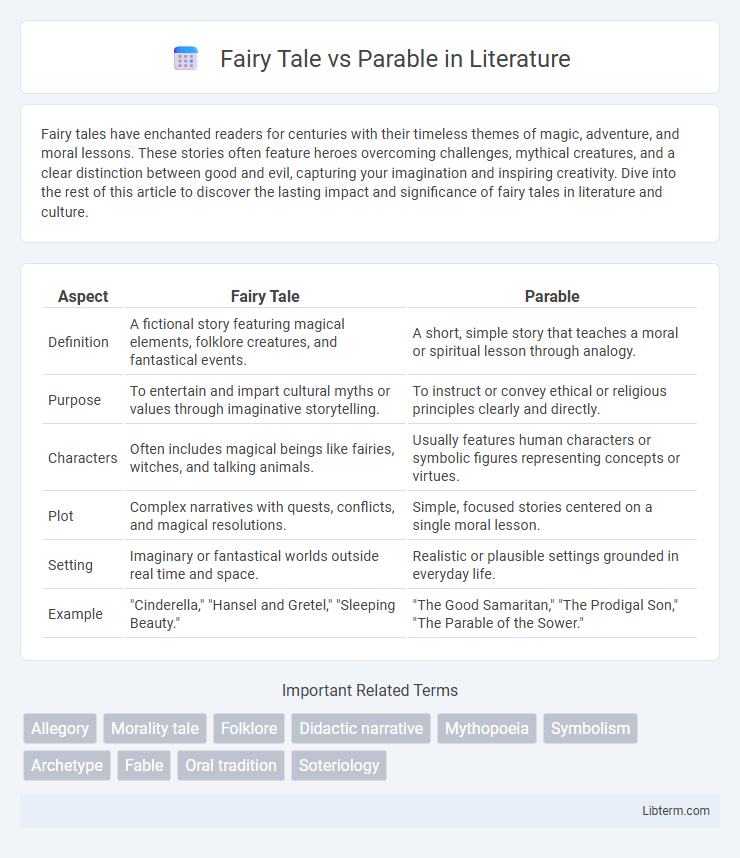Fairy tales have enchanted readers for centuries with their timeless themes of magic, adventure, and moral lessons. These stories often feature heroes overcoming challenges, mythical creatures, and a clear distinction between good and evil, capturing your imagination and inspiring creativity. Dive into the rest of this article to discover the lasting impact and significance of fairy tales in literature and culture.
Table of Comparison
| Aspect | Fairy Tale | Parable |
|---|---|---|
| Definition | A fictional story featuring magical elements, folklore creatures, and fantastical events. | A short, simple story that teaches a moral or spiritual lesson through analogy. |
| Purpose | To entertain and impart cultural myths or values through imaginative storytelling. | To instruct or convey ethical or religious principles clearly and directly. |
| Characters | Often includes magical beings like fairies, witches, and talking animals. | Usually features human characters or symbolic figures representing concepts or virtues. |
| Plot | Complex narratives with quests, conflicts, and magical resolutions. | Simple, focused stories centered on a single moral lesson. |
| Setting | Imaginary or fantastical worlds outside real time and space. | Realistic or plausible settings grounded in everyday life. |
| Example | "Cinderella," "Hansel and Gretel," "Sleeping Beauty." | "The Good Samaritan," "The Prodigal Son," "The Parable of the Sower." |
Introduction: Understanding Fairy Tales and Parables
Fairy tales are narrative stories featuring magical elements, mythical creatures, and fantastical settings designed to entertain and convey cultural values. Parables are simple, didactic stories that use everyday events to illustrate moral or spiritual lessons, often found in religious or philosophical texts. Understanding the distinct purposes and structures of fairy tales and parables enhances comprehension of their roles in storytelling and ethical teaching.
Origins and Historical Background
Fairy tales originated in oral traditions of ancient cultures, often passed down through generations as folk narratives embodying cultural values and supernatural elements. Parables emerged primarily from religious and philosophical contexts, exemplified by their use in ancient texts such as the teachings of Jesus in the New Testament and Buddhist scriptures. Both forms served as vehicles for moral education but differed in origin, with fairy tales rooted in mythic folklore and parables in didactic storytelling.
Defining Characteristics of Fairy Tales
Fairy tales feature magical elements, fantastical creatures, and a clear moral lesson often conveyed through good versus evil conflicts. These stories typically involve royalty, enchanted settings, and transformative quests, emphasizing imaginative storytelling and universal themes. The narrative structure usually follows a pattern of problem, struggle, and resolution, creating an engaging and timeless folklore tradition.
Key Elements of Parables
Parables are succinct narratives centered on human characters that illustrate moral or spiritual lessons through realistic situations and clear cause-and-effect relationships. Key elements include a simple plot, characters representing common human types, and a pointed message that invites reflection and ethical behavior. Unlike fairy tales, parables emphasize practical wisdom and direct application to everyday life rather than fantastical elements or imaginative settings.
Purpose and Intended Messages
Fairy tales primarily aim to entertain while subtly teaching moral lessons through magical and fantastical narratives, often addressing themes of good versus evil, bravery, and kindness. Parables are concise stories explicitly designed to convey clear ethical or spiritual messages, frequently employed in religious or philosophical contexts to provoke reflection and inspire moral behavior. The intended message in fairy tales is often more open to interpretation, whereas parables deliver a direct and deliberate moral teaching.
Common Themes and Motifs
Fairy tales and parables often explore universal themes such as good versus evil, moral lessons, and the transformative power of courage or kindness. Both genres utilize motifs like magical creatures, quests, and personification to convey their messages, though fairy tales emphasize fantastical elements while parables focus on straightforward moral teachings. These shared themes and motifs serve to engage audiences emotionally and intellectually, reinforcing cultural values and ethical behavior.
Storytelling Techniques and Structure
Fairy tales use imaginative storytelling techniques like magical elements, archetypal characters, and simple, repetitive structures to engage readers and convey cultural morals indirectly. Parables employ concise, realistic narratives with symbolic characters and situations designed explicitly to illustrate a clear ethical or spiritual lesson. Both rely on narrative structure, but fairy tales often emphasize fantasy and entertainment, while parables focus on direct moral instruction through relatable scenarios.
Cultural Impact and Adaptations
Fairy tales have significantly shaped Western culture through their timeless narratives and widespread adaptations in literature, film, and theater, often emphasizing magical and fantastical elements that reflect societal values and morals. Parables, rooted primarily in religious and philosophical traditions, offer concise, symbolic stories designed to convey moral or spiritual lessons, influencing ethical teachings and discourse across various cultures. Both genres have been adapted into modern media, influencing cultural norms by reinforcing societal values and providing frameworks for interpreting human experiences.
Moral Lessons: Direct vs. Symbolic
Fairy tales deliver moral lessons through direct narratives featuring clear distinctions between good and evil characters, making ethical messages straightforward and accessible. Parables convey moral lessons symbolically, using metaphorical stories that require interpretation to uncover deeper spiritual or practical meanings. This symbolic approach in parables encourages critical reflection and personal insight, contrasting with the explicit guidance found in fairy tales.
Conclusion: Choosing Between Fairy Tale and Parable
Selecting between a fairy tale and a parable depends on the desired narrative impact: fairy tales use imaginative settings and magical elements to convey moral lessons through engaging storytelling, while parables employ simple, realistic scenarios to impart clear ethical messages with direct applicability. Understanding the audience's preference for allegory versus fantasy helps determine the most effective format for teaching values or provoking reflection. Ultimately, the choice hinges on whether the goal is to inspire wonder and imagination or to provide straightforward guidance and moral clarity.
Fairy Tale Infographic

 libterm.com
libterm.com